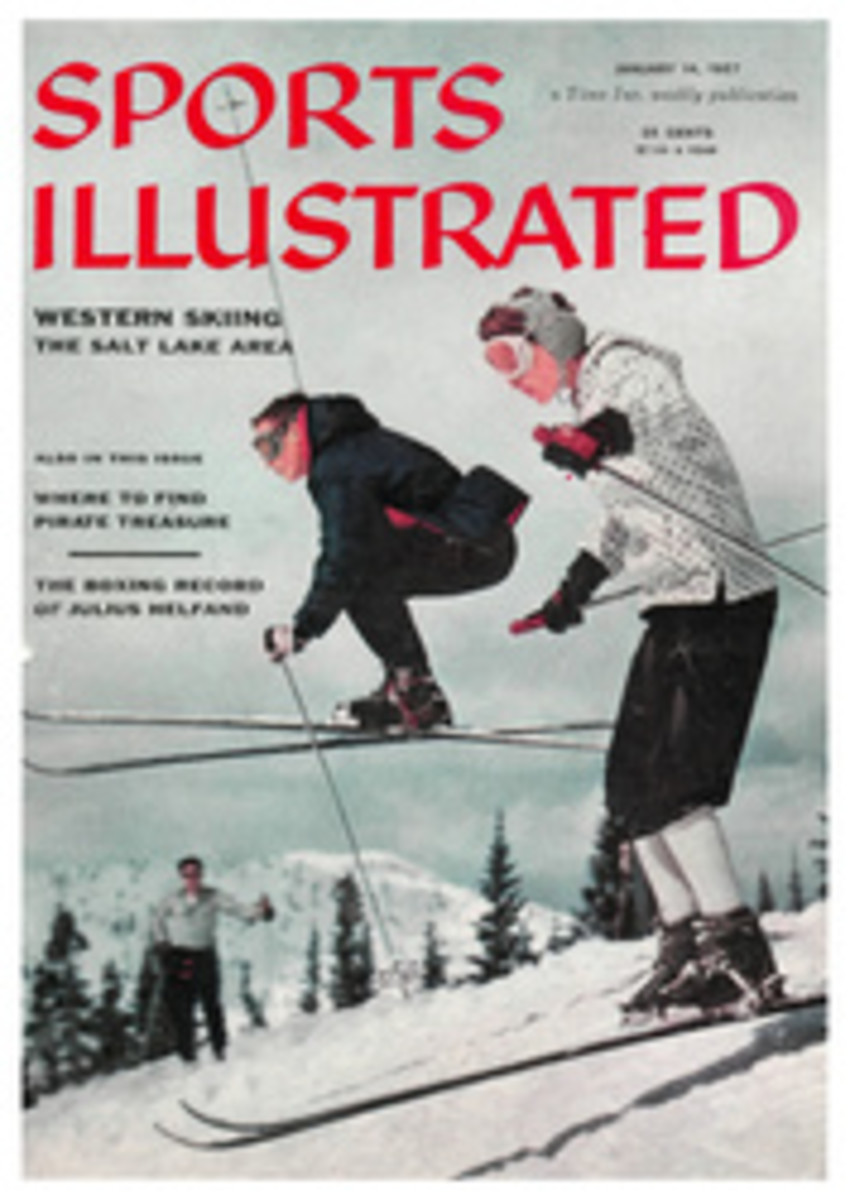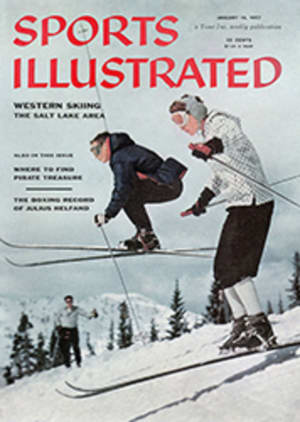
DUCK HUNTERS IN PARADISE
From the sloughs, rivers, marshes, bays and bayous of the nation, hunters are heading homeward this week after one of the most successful duck-shooting seasons in decades. As 1956 moved to a close, waterfowl funneled down the Mississippi Flyway, building to tremendous numbers in the low, lush wintering grounds formed by the great river and its many tributaries, interrupting their journey to linger on the hundreds of feed-filled lakes. Few hunters were more eager—or better prepared—to receive them than the 18 members of Missouri's Cuivre Club. Only 50 miles from St. Louis, in a kind of special super-heaven tucked away in the heaven that this area has come to represent for duck hunters, these men, business leaders not only of St. Louis but of the nation, foregathered each week at their massive 18-bedroom clubhouse (above), pondering early-morning blind positions, weather forecasts, current census reports. To the south, on a 50-by-25-mile stretch of rice-rich watery land around Stuttgart in eastern Arkansas, waterfowl crowded in millions to the bayous of the Duck Capital of the World. At Stuttgart's nine-member, 640-acre Drakes' Landing Club, the shooting last week had never been better. How good it was is shown on the following pages, in a unique photographic visit to Drakes' Landing and the Cuivre Club at the closing of a great duck-hunting year.
Morning of hunt (above) finds members ready at their cars. Here (left to right) are Richard Baldwin, Steedman-Baldwin Co.; Charles A. Thomas, president, Monsanto Chemical Co.; John H. Crago, Smith, Moore Co.; Henry M. Cook, Newhard, Cook Co.; Russell E. Gardner Jr., Reinholdt Gardner Co.; John H. Hayward, Reinholdt Gardner Co.; J. Wesley McAfee, president, Union Electric Co.; Sidney Maestre, chairman, Mercantile Trust Co.; Ira E. Wight Jr., Newhard, Cook Co.; and James H. Grover, retired chairman, St. Louis Union Trust Co. Below, Gardner, Grover, Cook and Crago review day with (left) David Calhoun Jr., president, St. Louis Union Trust Co.; Edwin H. Steedman, Steedman-Baldwin Co.; and Tom K. Smith, chairman, Boatmen's Bank.
COMFORT IS A KEYNOTE
A hundred years and four generations have passed since the first St. Louis hunters fought their way up the roily Mississippi to the barren, mud-covered plains near what is now O'Fallon, Mo., and set up camp on the tiny Cuivre River. A superhighway has since replaced the ruts of wagon trails, and a luxurious clubhouse stands where canvas tents once were pitched. Inside, everything is ready for the club members' comfort and convenience. Across from the clubhouse a staff of cooks prepares dinner in the dining building and sends an immaculately attired butler to announce the hour. In the kennels handlers feed ribbon-winning Labradors, while lights in the tackroom cast shadows on guides oiling guns and readying equipment. In the morning, at their leisure, the hunters will wend their ways to fog-blanketed blinds scattered across the waters, climbing into sunken olive barrels to wait for the birds.
Flickering fire warms David R. Calhoun Jr. (above, center) after chilly hour's ride from St. Louis. Comfortably settled on couch in foreground, John Hayward and James Grover relax and speculate on weather conditions for next day's hunt.
Around the poker table, Edwin Steedman, Tom K. Smith and Grover wait for others to arrive before drawing cards for morning's blind positions. Present ranch-type building was completed two years ago after fire destroyed club in 1953.
Quiet Relaxation is assured in private bedrooms, each one marked with a brass nameplate. Grover, a spry hunter at 83, reads before turning in.
Adjoining tackroom harbors neatly stowed hunting gear. Charles Thomas uses jack to remove boots.
Scanning skies, Russell Gardner Jr. (foreground) and Richard Baldwin head for blinds in decoy-laden aluminum motor skiff.
Boost from guide helps Gardner (above) climb into sunken blind. Below, with partner Baldwin, he aims at ducks overhead.
Approaching dock, J. W. McAfee and Sidney Maestre pass by truck and Model A Ford, prized by members for mud-driving.
Proud duck hunters, Ira Wight Jr. (left) and John Crago, pose with the day's limit after successful morning in the blinds.
DRAKES' LANDING: DUCKS BY THE MILLION
Farther south along the flyway, where the waters of the Arkansas and White rivers irrigate a triangle of rice-rich abundance, the Drakes' Landing Club nestles within a flooded forest. One of the oldest duck clubs in Arkansas, its 640 acres stretch into the heart of the famed Stuttgart hunting area. Twenty-five years ago, when the original nine members carted all facilities from Pine Bluff every weekend, tents were pitched and decoys set for each hunt. Today the club's caretaker sets out the decoys at the beginning of each season in a dozen permanent locations. The brick clubhouse sleeps 18, enabling each member to bring one guest. Only the ducks have been unchanged by progress. By the millions they cover the flood lands with a feathery blanket, luring the hunters into the early dawn.
Predawn breakfast is enjoyed by (left) member's son E. Russell Lambert Jr. of Chalmette Plantation; S. Ray West, partner, F. G. Smart Motors; Mrs. West and Dr. E. C. McMullen, for 26 years Drakes' Landing Club president. Walter Trulock Jr., cotton planter and ginner, sits with other hunters at rear table, as two club cooks dish out bacon and eggs in the little kitchen beyond.
MORNING COMES WITH MISTS AND MALLARDS
Fog mingles with the ends of night and fingers a procession of fiat-bottomed aluminum duck boats as hunters paddle silently away from the Drakes' Landing clubhouse. It is a half hour before sunrise. Anxious eyes search the blackened skies. Impatience makes the journey seem longer and shooting positions farther away. Tangled roots scratch against the bottoms of the boats, growling in the quiet. Like sentinels guarding a drowned land, the shadows of dead cypress trees cast somber reflections across the inky waters. Among them, pin oaks, rosewoods, overcups and pecan trees wait for another spring to sprout green leaves again. Clustered on branches everywhere, mistletoe drop waxen berries to the pools below and rustle gently with the wind. On the many lakes scattered throughout this watery woodland, decoys rock softly on the swells. Early morning filters pink through the trees, shifting the shadows as it comes, touching a hunter motionless beside a willow. Overhead, like dark specks in the dawn sky, a flock of ducks goes by. From the recesses of the woods the hunters begin their calls, coaxing the birds with loud, plaintive sounds. Down from the sky they fall, circling, dipping, circling again. The calls change, grow frenzied, more insistent and are answered. Back and forth ducks and hunters talk in excited, guttural conversation. In an ever-narrowing circle the ducks lose altitude, wingbeats audible above the chatter. Then, setting their wings, they push white bellies into the wind and drop toward the decoys below. The shots are loud, rapid. Three mallards plummet to the calm waters, spreading great rings from the places where they strike. In the distance, the remainder of the flight disappears into the sky. A hip-booted hunter walks through knee-deep water to the fallen birds. With twigs he props them up among the decoys and returns to wait beside his tree. At Hurricane Hole, Tin Can, Nine Oaks, or East Taylor other Drakes' Landing members wait, scanning the brightening skies. Some crouch in willow-covered blinds, others under large bushes, still others behind camouflaged boats, breathlessly, thigh-deep in water. By 7:30 almost any morning, the hunters usually have shot their limits and the day's hunt is over. An hour's drive away, in Pine Bluff, they will attend bank meetings, sell automobiles, negotiate cotton sales and treat patients at the opening of a regular business day.
With wary paddle strokes, S. Ray West (foreground) and Dr. E. C. McMullen make their way down a channel to the shooting stands.
Luring the ducks, J. W. Bellamy Jr., president, National Bank of Commerce, and Ray West crouch against tree and send out eager calls.
Wading through the shallows of Hurricane Hole, Walter Trulock Jr. (right) heads homeward with sons Leo and Walter III after all three bagged limits within 45 minutes of legal shooting hour. Together they look skyward for one last glimpse of birds before returning to the city. In their wake, decoys bob up and down upon the rippled water, waiting for still another day.
Answering hunters' calls, ducks drop from sky into shooting range as S. Ray West swings shotgun to shoulder and prepares to fire.
PHOTO
ED STEIN
AN OASIS IN THE GLOOM, CUIVRE CLUB GLOWS THROUGH ITS PICTURE WINDOWS FAR INTO NIGHT
MAP
ED STEIN
WHERE RIVERS MEET, DUCKS ABOUND
MISSOURI R.
MISSOURI
ARKANSAS
ARKANSAS R.
LITTLE ROCK
PINE BLUFF
CUIVRE CLUB
ST. LOUIS
[Solid line]Car travel
[Dotted line]Plane travel
[Solid fill]Excellent duck Shooting areas
DRAKES' LANDING CLUB
STUTTGART
WHITE R.
SIXTEEN PHOTOS
ED STEIN
PHOTO
BEHIND EXCELLENTLY EQUIPPED BAR, CUIVRE CLUB PRESIDENT MAHLON B. WALLACE JR. PREPARES THE DRINKS
PHOTO
REFRESHMENTS ARE SPEEDED FROM DINING BUILDING
PHOTO
EVENING ENVELOPS DRAKES' LANDING CLUB, PERCHED HIGH ON A KNOLL IN THE HEART OF STUTTGART'S FLOODED FOREST

